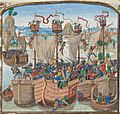Cantabria facts for kids
Cantabria is a region in the north of Spain. It has 563,000 people living in it. In Cantabria most people speak Spanish. The people of Cantabria have autonomy in Spain, which means they have their own local government and much control over their region. The capital is Santander. This city is on the coast of the Cantabrian Sea and is very popular with tourists. Cantabria belongs to the Green Spain, the name given to the strip of land between the Cantabrian Sea and the Cantabrian Mountains in northern Spain.
Contents
Culture
Many different examples of prehistoric cave art have been found, suggesting the Cantabrian culture is at least 15,000 years old. Cave art is the best known feature of the Cantabrian life. The latest round of systematic cave explorations began in the early 1970s. Now new art can be discovered every year. Some of the cave art is engraved, and others are painted. Much of the cave art is of animals. There are often pictures of red deer found from this area of Spain. There are also other unusual symbols that can be found. This attracts much interest and many tourists to this culture. The Cantabrian life revolves mainly around art, tourism, and fishing. Rich deposits of coal, iron, and zinc are also mined in the Cantabrian Mountains. Tourism is a very large part of the Cantabrian life, and their economic success.
Climate
Cantabria is known for a rainy and cool climate. The region is also greener than southern Spain and is very mountainous.
Images for kids
-
The source of the Asón River
-
Panorama of the Cantabrian mountains to the left and the port city of Santander in the distant right. The peak Alto de Brenas in Riotuerto has a height of 579 metres.
-
Brañas, or mountain prairies in the municipality of Arenas de Iguña. Tordías Peak is 968 metres high.
-
Population pyramid for Cantabria for 2006 from the municipal planning authority.
-
Battle of La Rochelle. Castilian army, formed by Cantabrians from the Brotherhood of the Four Cities, defeated the English army, getting the control of the English Channel for the Crown of Castile.
-
A statue in Santander erected in honor of Cantabrian artillery captain Pedro Velarde y Santillán, hero of the Spanish war of independence, who died 2 May 1808, during the uprising against the French occupation of Madrid.
-
Banco Santander headquarters, in Paseo de Pereda, Santander
-
Parayas airport, located in the municipality of Camargo, 5 km from Santander
-
Altamira Cave paintings, made by Cro-Magnons.
-
International University Menéndez Pelayo. Palacio de la Magdalena. Venue for the summer courses of the UIMP (Santander). It also was a seasonal residence for kings of Spain.
-
Trainera regatta at the Santander bay
See also
 In Spanish: Cantabria para niños
In Spanish: Cantabria para niños
























